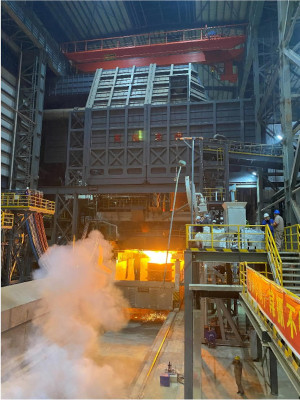- EAF Quantum furnace and twin ladle furnace have a tapping weight of 120 metric tons
- Very low electrical energy and low electrode consumption
- High productivity through low tap-to-tap time
- Plant concept reduces working costs and CO2 emissions
In June, Chinese steel producer Guilin Pinggang Iron and Steel Co., Ltd. (Guilin Pinggang) issued the final acceptance certificate (FAC) for an EAF Quantum electric arc furnace with a tapping weight of 120 metric tons and a 120 metric ton twin ladle furnace supplied by Primetals Technologies. The furnaces were set up in a new production facility in Pingle near Guilin in Guangxi Province, which is intended to serve the growing market for rebars. The EAF Quantum is designed to handle scrap steel of varying composition and quality. The electrical energy requirement of the electric arc furnace is extremely low because the scrap is preheated. Due to a high automation level of the Quantum concept the power-off time could be reduced by appr. half to a conventional EAF. All this reduces the operation costs and the CO2 emissions beside the increase of productivity.
Guilin Pinggang is privately owned and located in Pingle near Guilin city in Guangxi Province. The enterprise has an annual production capacity of 1.2 million metric tons, and produces rebars, wire and other steel elements for the construction industry. Primetals Technologies has supplied the complete mechanical and electrical process equipment for the new EAF Quantum electric arc furnace and the twin ladle furnace. The balance of plant auxiliary equipment and services have been provided by a local design institute.
The EAF Quantum developed by Primetals Technologies combines proven elements of shaft furnace technology with an innovative scrap charging process, an efficient preheating system, a new tilting concept for the lower shell, and an optimized tapping system. This achieves very short tap-to-tap times. The electric energy consumption is considerably less than that of a conventional electric arc furnace. Together with the lower consumption of electrodes and oxygen, this gives an overall advantage in the specific conversion cost of around 20 percent. In comparison to conventional electric arc furnaces, total CO2 emissions can also be reduced by up to 30 percent per metric ton of crude steel.


